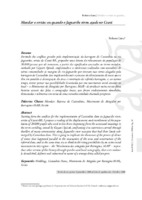Mundar o sertão: ou quando o Jaguaribe virou açude no Ceará
Abstract
Partindo dos conflitos gerados pela implementação da barragem do Castanhão no rio Jaguaribe, sertão do Ceará-BR, proponho uma leitura do relocamento da população de 20.000 pessoas que ali moravam, a partir dos significados associados ao termo mundar, cunhado por Gayatri Spivak, confrontado-o a entrevistas realizadas com moradores de várias comunidades às margens do rio Jaguaribe que tiveram suas terras alagadas pela barragem do Castanhão. Isso implicará discutir o processo de silenciamento de vozes que se deu em paralelo à desocupação da área e construção da referida barragem, e, ao mesmo tempo, tentar pensar nas possibilidades levantadas por um movimento social atuante no local – o Movimento de Atingidos por Barragens, MAB - de produzir outra versão dessa história através das falas e cartografias locais, que foram violentamente demolidas, desmatadas e submersas em nome de uma estranha entidade chamada progresso. Starting form the conflicts for the implementation of Castanhão dam in Jaguaribe river, sertão of Ceará-BR, I propose a reading of the displacement and resettlement of the population of 20.000 people who used to live there, beginning from the associated meanings to the term worlding, coined by Gayatri Spivak, confronting it to interviews carried through dwellers of many communities along Jaguaribe river margins that had their lands submerged by Castanhão dam. This is going to implicate the discussion of the process of silence of voices that happened parallel to the evacuation of the area and construction of the referred dam, and at the same time, tryto think in the rising possibilities by an active social movement in this region – the “Movimento dos atingidos por Barragens, MAB” – to produce other version of this history through speeches and local cartography, that were violently demolished, deforest and submersed in name of a strange deity called progress.
URI
https://hdl.handle.net/20.500.12219/1622http://www.ava.unam.edu.ar/images/13/pdf/ava13_03_lima.pdf
Collections
- Revista Avá [353]




